JOHN S. MASON - PREVENTION OF
ENVIRONMENTAL DISASTER AT CWMRHEIDOL
MINE, CENTRAL WALES, EARLY 1990s
Note: to return to the John's Conservation & Environmental page
click on EXIT at
the bottom
of any of these pages.
PART
3 - The Surge!
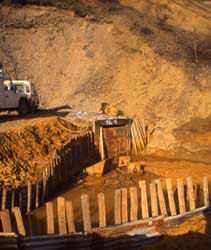
March 1993...... |
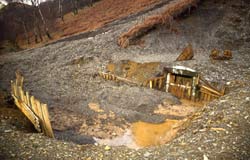 November 1993! November 1993!
What had happened? Clearly an overwhelming flood: after all there had
been heavy rain on and off through the autumn. But this surge had come
from above. It had come down the drainage gully that takes the
discharge from the No 6 adit. Higher up it had scoured to bedrock and
washed away several trees. The next step was to try to find out why so
much water had suddenly entered the workings to exit from No 6. It
didn't take long... |
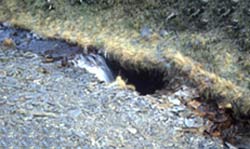
Here
it is - the
stream known as Nant Bwlchgwyn to the east of Ystumtuen. The course of
the stream follows in part the outcrop of the lode. Subsidence has
occurred and the entire stream has entered old workings. Since all of
these workings - Ystumtuen, Penrhiw and Bwlchgwyn - are drained by No 6
adit at Cwmrheidol, here we have the culprit. |
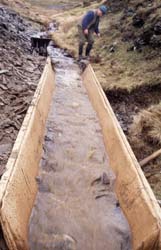
In
the Spring of
1994 we therefore set out to repair Nant Bwlchgwyn, by culverting it
straight over the subsidence. Here we are digging the culvert into
place and have just turned the water-flow back on its correct course... |
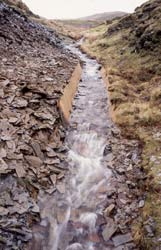
And
here is the nearly-completed job.
However, caution is advised, as there are other workings in this area
and the potential for further subsidence needs to be assessed and dealt
with, if Cwmrheidol is to avoid further surges like that of late 1993! |
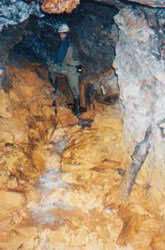
Attention then
turned to the No 6 Adit at Cwmrheidol, where a shaly dam had developed
in an area where the roof was steadily crumbling close to the adit's
intersection with the lode. This image depicts the general scene at
this point, way in underground. |
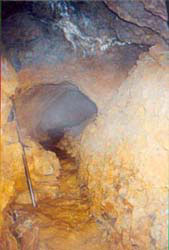
The
dam was gradually lowered bit by bit
to avoid any sudden water surges. Beyond lay tunnels left and right
driven along the lode. The left-hand one was walled-up but archival
work by Simon Hughes had already determined that it connected down to
No 9 by a winze. Such tunnels are driven with a slight gradient
"outbye" - that is, towards the adit, to allow water to flow outwards.
But, because the water level was so high, it had overcome the gradient,
so that it was able to escape down the winze into No 9. The removal of
the dam allowed the correct direction of flow to be re-established. |
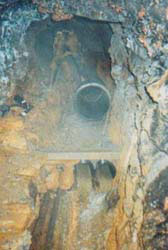
After removing
the dam, action was taken to ensure that water flow and human access
would be possible in the event of further falls of ground. Strong
twin-wall pipes were deployed: two at ground level to take the water,
which were then buried, and a third bigger-gauge one, here being put
into place. This too was buried. The pipes extend well out into the
tunnels beyond, to avoid roof-falls blocking them.
That
concluded
the works at Cwmrheidol back then. The aim was to maintain the status quo with respect to
underground
drainage. The longer-term treatment of this drainage is a problem of
much greater magnitude which, it is hoped, will be tackled eventually.
The risks of potential subsidence and more sudden water surges, due to
the juxtaposition of old stopes and rivers in the Ystumtuen area, is a
problem that will not go away until it is fully assessed and dealt with
in an appropriate manner. |
BACK
EXIT
|